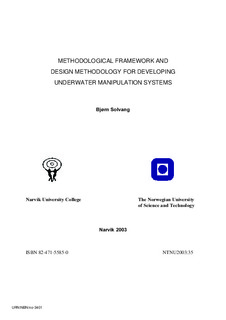| dc.description.abstract | Until recently, underwater manipulation tasks have been conducted by human divers alone or in co-operation with ROVs equipped with one or two manipulator arms. Divers are flexible and can perform a lot of different work tasks, but diving operations are expensive and there is a great deal of risk to enter such a hostile environment.
Oil drilling operations around the world are moved into deeper water compared with those only a few years ago, and the humans can not be present in water depths below 600 meters maximum. So to be able to interfere with the sub-sea installations, to conduct inspection, repair and maintenance operations, there is a need to have automatic equipment with the necessary capability to perform both planned and unplanned intervention tasks.
In general there are two different ways to automate the work tasks:
-Either by creating a set of special equipment, specially made for every work task or
-By building/using a robotic systems
The first equipment offers less flexibility, and even a small change in the external conditions of the work task makes it necessary to physically modify the equipment. The robotic solution offers higher flexibility, but is more complicated to design and as well operate.
In this dissertation I have identified those underwater intervention work tasks that exist today and those that will be forced upon us in the near future, due to the strong incentive to “get the man out the water”. The bare amount of different work classes is a clear incentive to choose a flexible instead of a specialised solution when it comes to intervention equipment. Thus, the robotic solution (ROV-manipulator), which offers the necessary flexibility, is selected as the R&D subject of this dissertation.
The increasing rigorous requirements from off-shore oil and gas fields on underwater XQPDQQHG manipulation in the hostile and unstructured/semi-structured sub-sea environment require constant improvement of the ROV-based underwater manipulation systems. Thus, there is a need to develop methodologies for aiding to optimally and formally develop and design new generation underwater unmanned manipulation systems. For meeting such necessity, this dissertation works to identify an overall concept and methodological framework for underwater manipulator system development.
Further, the serial manipulator is identified to be a natural solution for the workspace constraint environment, and the serial structure is selected for further analysis in this dissertation. I have identified the necessity of developing a precise design methodology, for aiding system designers to design a precise underwater serial arm manipulator working in a workspace constraint environment, capable of doing high precision work.
During the design stage of a precisive manipulator system the necessity of evaluation loops has become clear. The design team needs to evaluate the effect of their design considerations/decisions upon the precision requirement. Thus, an iterative method of “design – evaluation - design-evaluation” is suggested as the precise design methodology. Gaining knowledge of the effect of possible choices enables the design group, before too many ruling decisions has been made, to make an optimum solution.
The precision evaluation or as we say, error analysis methodology, involves a procedure which aims to identify physical errors, find their influence onto the kinematic chain, calculate the error effected real kinematic chain and compare the ideal end-effector pose with the real kinematic pose, so as to identify the single error influence or selected (all) error influence. Both theoretical results and a case study is presented in this dissertation.
As the final step in the general design procedure, a prototype is to be built and tested. The ISO 9283 standard “Manipulating industrial robots, performance criteria and related test methods” describes the test methods for a set of important performances of the manipulator system. However, the outcome from the performance measurements is a numerical value of how big the deviation from the ideal selected reference is. Performance measures does not state why and from where the errors origin from. This latter is especially important for the designer to have more knowledge about, because he/she may have to make changes to the construction, if some of the performance measurement is out of the specified requirements. In the final part of this dissertation, an experimental error mapping methodology is outlined. With the benefit of giving the designer a possible way to split up the numerical value from the performance measurements and map these numerical values to specific parts or areas of the construction. | nb_NO |
